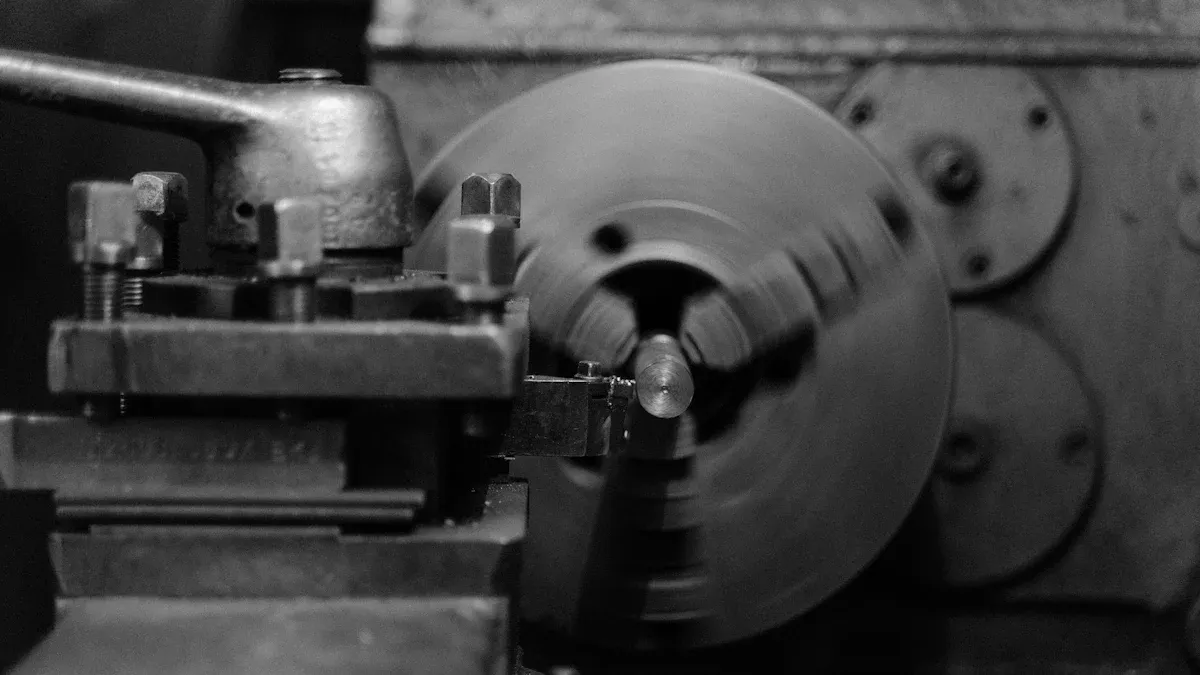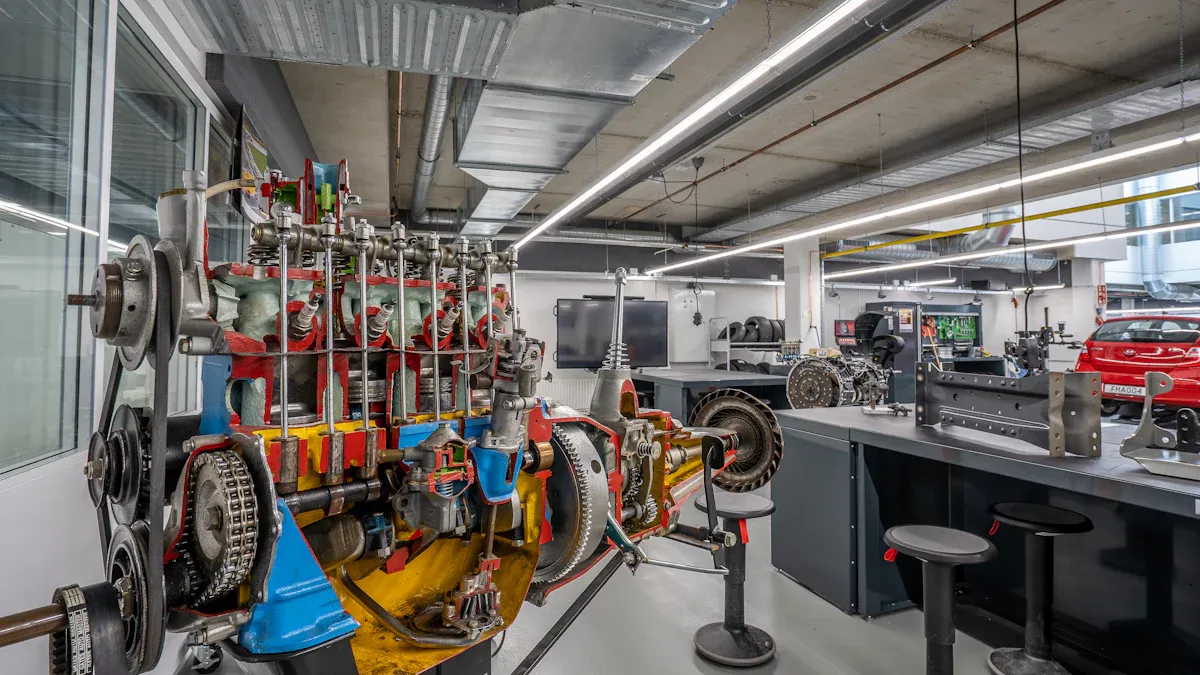
Do you want to save money while keeping your production running smoothly? Repairing your legacy mold is the answer. Instead of spending heavily on new molds, you can restore your existing ones with injection mold repair services. This approach reduces costs, extends the lifespan of your molds, and ensures minimal downtime. By choosing repair over replacement, you keep your operations efficient and cost-effective. Take control of your production expenses today and invest in a solution that works for you.

Repairing your molds instead of replacing them can save you significant money. Creating new molds is expensive, especially for complex designs. By opting for injection mold repair, you can restore your existing molds to optimal condition without the high costs of starting from scratch.
For example:
- A manufacturer of orthopedic devices faced challenges with multiple molds for complex production. By using mold simulation to identify issues early, they optimized the design and reduced costs. This approach saved time and money while ensuring a seamless fit for mass production.
Statistical data also highlights the financial benefits of repair. Consider the following comparison:
| Manufacturer | Initial Cost | Shots Guaranteed | Total Pieces | Piece Price | Sales Revenue | Total Cost | 2-Year Savings |
|---|---|---|---|---|---|---|---|
| Competitor | $245,000 | 1 Million Shots | 16 Million | $0.050 | $800,000 | $1,845,000 | $0 |
| All-Plastics | $245,000 | 2 Million Shots | 16 Million | $0.055 | $880,000 | $1,760,000 | $85,000 |
This table demonstrates how repair and mold maintenance can lead to substantial savings over time. By extending the lifespan of your molds, you reduce the need for frequent replacements and lower your overall production costs.
Production downtime can disrupt your operations and lead to financial losses. Injection mold repair helps you minimize these interruptions by addressing issues before they escalate. Predictive maintenance models play a crucial role in this process.
By using cognitive analytics, you can identify deviations from normal behavior and anticipate failures. This proactive approach ensures that potential problems are resolved quickly, keeping your production line running smoothly. Advanced predictive techniques, such as ensemble methods, enhance the accuracy of real-time anomaly detection. These methods allow you to monitor your molds continuously and adapt to any changes immediately.
Tracking key performance indicators (KPIs) like cycle times and downtime also helps you stay ahead of potential issues. By analyzing these metrics, you can maintain operational efficiency and reduce costly delays. With injection mold repair, you can keep your production on track and avoid unnecessary disruptions.
Repairing your molds not only saves money but also supports your sustainability goals. By extending the life of your molds, you reduce waste and conserve resources. This approach aligns with environmentally friendly practices and enhances your company's reputation.
Sustainable manufacturing practices include:
- Reducing cooling time to increase productivity.
- Saving energy to lower operational costs.
- Shortening lead times to improve efficiency.
Additionally, using renewable and recycled materials in your molds reduces your carbon footprint. Optimizing processes minimizes waste, while advanced cooling techniques enhance productivity and reduce energy consumption.
| Practice | Impact on Sustainability |
|---|---|
| Use of renewable and recycled materials | Reduces carbon footprint and conserves resources |
| Optimization of processes | Minimizes waste and enhances efficiency |
| Advanced cooling techniques | Increases productivity and reduces energy consumption |
By choosing injection mold repair, you contribute to a more sustainable future. This decision not only benefits the environment but also improves your bottom line.
Over time, molds experience natural wear and tear due to repeated use. Every production cycle subjects the mold to stress, which can lead to cracks, surface degradation, or misalignment. These issues reduce the mold's efficiency and compromise the quality of your products. Regular maintenance can help you identify these problems early, but ignoring them can result in costly repairs or even complete mold failure.
Historical records show that mold-related issues have been a concern for centuries. For instance, in the 1920s, horses in Ukraine suffered from illnesses caused by moldy feed, leading to the identification of toxic molds like Stachybotrys. While this example relates to biological molds, it highlights how neglecting mold problems can have serious consequences. Similarly, in manufacturing, failing to address wear and tear can disrupt your operations and increase expenses.
Improper handling or incorrect setup can cause significant damage to your molds. For example, using excessive force during installation or failing to follow proper procedures can lead to physical damage. This shortens the mold's lifespan and increases the likelihood of production delays.
Consider a medical device company that faced frequent mold failures due to poor handling protocols. By improving their processes, they extended their molds' lifespan from 800,000 cycles to over 1 million cycles. This example demonstrates how proper care and troubleshooting can prevent unnecessary damage and save you money in the long run.
Outdated or poorly designed components are another common issue with legacy molds. Molds made from inferior materials or with suboptimal designs often fail to meet modern production demands. For instance, a facility using abrasive glass-filled polymers found that their molds lasted only 600,000 cycles, compared to 1 million cycles for standard thermoplastics.
Additionally, repair technicians often identify long-term issues caused by design flaws or outdated features. Upgrading these components can significantly improve your mold's performance and extend its usability. By addressing inefficiencies, you can enhance your production process and reduce downtime.
Tip: Regular troubleshooting and upgrading outdated components can help you avoid costly replacements and keep your molds running smoothly.

The first step in the mold maintenance process is a thorough inspection and diagnosis. This phase ensures that every issue is identified before repairs begin. You can rely on advanced diagnostic techniques to pinpoint problems with precision.
Here are some of the most effective methods used during this stage:
| Diagnostic Technique | Description |
|---|---|
| Detailed Imaging | Provides comprehensive evaluations of part surfaces and structures, detecting irregularities. |
| Precision Measurement Tools | Instruments like optical comparators and digital calipers ensure exact measurements for compliance. |
| Non-Destructive Testing (NDT) | Methods like thermography and acoustic emission testing assess internal integrity without damage. |
| Compliance Verification | Processes that ensure adherence to industry standards and regulations for safety and performance. |
By using these tools, you can uncover hidden defects and ensure your molds meet industry standards. This proactive approach saves time and prevents costly production delays.
Once the issues are identified, advanced repair techniques come into play. These methods restore your molds to their original condition or even improve their performance. Skilled technicians use cutting-edge tools and technologies to address wear, damage, or outdated components.
Some common techniques include:
- Laser Welding: Repairs cracks and fills gaps with precision, ensuring a seamless finish.
- Surface Polishing: Restores smoothness to worn-out surfaces, improving product quality.
- Component Upgrades: Replaces outdated parts with modern, efficient alternatives to enhance durability.
These techniques not only fix existing problems but also extend the lifespan of your molds. By investing in advanced repairs, you reduce the need for frequent replacements and keep your production running smoothly.
Quality assurance is a critical part of the mold maintenance process. After repairs, rigorous testing ensures that your molds perform reliably over time. Key metrics and tests help verify the success of the repair process:
| Metric | Description |
|---|---|
| Defect Resolution Percentage | Indicates the efficiency of the development team in fixing reported bugs. |
| Defect Age | Measures the average time taken to resolve defects, indicating the maturity of the QA process. |
| Test Execution Status | Provides a snapshot of the testing process, showing how many tests have passed, failed, or are blocked. |
By focusing on these metrics, you can ensure that your molds deliver consistent results. Regular maintenance further enhances their longevity, reducing the risk of unexpected failures. This commitment to quality keeps your operations efficient and cost-effective.
Tip: Partnering with a reliable repair service ensures that every step of the process, from inspection to testing, is handled with expertise.
When deciding between repairing or replacing a mold, the financial implications are a critical factor. Repairing your mold often costs significantly less upfront compared to creating a new one. For example, repairing a damaged mold might only require a fraction of the cost of designing and manufacturing a replacement. This makes repair an attractive option for businesses looking to save money.
However, the long-term financial picture is equally important. While replacement involves higher initial costs, it can sometimes offer better value over time. A new mold may come with updated features, improved efficiency, and a longer lifespan, which can offset the upfront expense. On the other hand, frequent repairs to an aging mold can add up, potentially surpassing the cost of a replacement.
To make the best decision, you need to evaluate your production needs, the condition of your existing mold, and the costs associated with repairs. By carefully analyzing these factors, you can choose the most cost-effective solution for your business.
Repairing your mold offers several long-term benefits that go beyond immediate cost savings. First, it extends the lifespan of your existing mold, allowing you to maximize your initial investment. With proper maintenance, a repaired mold can continue to deliver high-quality results for years.
Second, repair minimizes production downtime. Replacing a mold often involves lengthy lead times for design and manufacturing. In contrast, repair services can quickly address issues and get your mold back in operation. This ensures that your production schedule stays on track, saving you both time and money.
Finally, repair supports sustainability. By choosing to repair rather than replace, you reduce waste and conserve resources. This aligns with environmentally friendly practices and enhances your company's reputation as a responsible manufacturer. Repairing your mold is not just a smart financial decision—it’s also a commitment to sustainability and efficiency.
Replacing a mold may seem like a straightforward solution, but it often comes with hidden costs that can strain your budget. These costs include:
- Design Changes: Adjustments to meet new requirements or correct design flaws can increase labor and material expenses.
- Delivery Delays: Coordination issues during the replacement process can disrupt production schedules, leading to economic losses.
- Quality Issues: Defects in the new mold may require additional repairs, halting production and impacting your reputation.
- Intellectual Property Costs: Protecting mold designs involves legal fees and time, which are often overlooked.
Additionally, mold replacement can lead to unexpected expenses related to mold maintenance and setup. For instance, new molds may require adjustments to your production line, adding to the overall cost.
Statistics also highlight the financial risks of mold replacement. Mold remediation costs can range from a few thousand to hundreds of thousands of dollars, depending on the extent of the issue. Furthermore, dampness and mold affect 30% to 50% of commercial buildings in the U.S., emphasizing the prevalence of mold-related challenges.
By understanding these hidden costs, you can make a more informed decision. Repairing your mold often provides a more predictable and cost-effective solution, helping you avoid the financial pitfalls of replacement.
Choosing the right injection mold repair service can significantly impact your production efficiency and costs. To make the best decision, you should evaluate several critical factors:
- Signs of Mold Wear: Look for surface roughness, inconsistent part dimensions, or longer cycle times. These issues indicate the need for immediate repair.
- Cost vs. Replacement: Compare the cost of repair with the expense of replacing the mold. Repairs often save money while maintaining production continuity.
- Mold Longevity: Assess how long the repaired mold will last and whether new technology can improve its performance.
- Production Volume: High-volume production may require new molds, but repairs are ideal for low-volume operations.
Additionally, a reliable service provider should demonstrate professionalism, independence, and the ability to train your team in mold maintenance training. This ensures that your molds remain in excellent condition for years to come.
Expertise and advanced technology are essential for effective mold repair. A skilled technician can identify defects and apply corrective actions with precision. Modern tools, such as the ALFlak laser welder, enable repairs that were once impossible. This technology ensures high-quality results, giving you confidence in the service provided.
When selecting a repair service, prioritize those that invest in continuous learning and cutting-edge equipment. Their knowledge of plastics processing requirements and commitment to innovation will ensure your molds perform at their best. Advanced tools also reduce repair time, minimizing production downtime and saving you money.
Customer feedback is a valuable resource when choosing a mold repair service. Look for providers with high Customer Satisfaction (CSAT) scores, which reflect their ability to meet or exceed expectations. CSAT scores are calculated using this formula:
CSAT Score = (Number of Satisfied Customers / Total Respondents) x 100
A high score indicates consistent quality and reliability.
Additionally, consider the impact of customer retention. Studies show that a 5% increase in retention can boost profits by 25% to 95%. Regularly reviewing feedback helps identify areas for improvement, ensuring you receive the best service possible. By choosing a provider with excellent reviews, you can trust that your molds will be repaired to the highest standards.
Injection mold repair offers you a smart way to extend the life of your molds while saving money. By addressing wear, damage, or outdated components, you can maintain production efficiency and avoid costly replacements. Choosing a reliable repair service ensures your molds perform at their best, reducing downtime and supporting sustainability. Take action today to protect your investment and keep your operations running smoothly. Repairing your molds is not just practical—it’s a decision that benefits your business and the environment.
Injection mold repair restores damaged or worn molds to their original condition. It helps you save money, reduce downtime, and extend the lifespan of your molds. This process ensures your production remains efficient without the need for costly replacements.
Look for signs like surface cracks, misaligned parts, or inconsistent product quality. Increased cycle times or frequent production errors also indicate that your mold may need immediate attention. Regular inspections can help you catch these issues early.
The time required depends on the extent of the damage. Minor repairs may take a few hours, while more complex issues could require several days. A reliable service provider will give you an accurate timeline after inspecting your mold.
Yes, repairing molds can enhance product quality. Fixing surface wear, cracks, or outdated components ensures that your molds produce consistent and high-quality parts. This helps you maintain customer satisfaction and avoid production defects.
Look for a service provider with expertise, advanced technology, and positive customer reviews. Ensure they offer thorough inspections, use modern tools, and have a proven track record of successful repairs. A reliable partner will help you maximize your mold's performance.